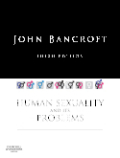
New edition of a classic multi-disciplinary reference book on human sexualityand its problems written by one of the foremost authorities in the field. INDICE: PART 1 1. Introduction a) Personal statement 2. Models of Human Sexuality; the role of theory PART 2 - THE BIOLOGICAL BASIS OF HUMAN SEXUALITY 3. Reproductive hormones and sexual anatomy (i)The fundamental role of reproductive hormones a. Peptides b. The anterior pituitary-gonadal system c. Steroid hormones (ii) Biological rhythms and normal patterns of hormonal change a. Themenstrual cycle, b. Pregnancy and lactation c. The menopause (iii) Anatomy ofgenitalia - The woman a.The clitoris b.The vulva c.The vagina d.The uterus e.The ovaries f.The blood supply g.The nerve supply (iv) Anatomy of genitalia - The man i. The penis ii. The testes iii. The blood supply iv. The nerve supplyv. Effects of steroids on the reproductive tract and secondary sexual characteristics vi. Biological rhythms and normal patterns of hormonal change 4. Sexual arousal and response - the psychosomatic circle (i) Sources of information (ii) The brain and sexuality a. History b. A brief introduction to the brain c. The emotional brain i. Emotional excitation and inhibition d. Where does sexfit in? e. Central control of sexual excitation and inhibition i. The need for inhibitory mechanisms ii. Peptides iii. The monoaminergic systems & sexual response iv. Human evidence 1. Dopamine (iii) Genital response (anatomy and physiology) in women and men. -Effects of central inhibition (1999) (iv) Orgasm and seminal emission -Refractory period and sexual satiation -Brain imaging (v)Information processing and sexual response -cognitive -visual -olfactory -tactile -Brain imaging (vi) Relationship between mood and sexual response a. Anxiety i. Psychogenic ED v GAD (Bancroft 2000 -alpha blockade paper) (vii) The role of hormones in sexual response (viii) Over all conclusions about the complexity, the need for simplified models and the relevance of the Dual Control b. Cite McKenna PART 3 THE INTERACTION BETWEEN BIOLOGY AND CULTURE 5.Sexual Development (i) The developmental process -Theoretical approaches and The Three Strand Model (ii) Sexual differentiation and the development of gender differences Sexual differentiation into male or female (i) Chromosomes (ii) Gonads (iii)Hormones (iv) Internal sex organs (v) External genitalia (vi) Gender of assignment (vii) Gender identity d. Sexual Differentiation of the brain e. Anomalies of sexual differentiation i. Sex Chromosome aneuploidies ii. Inborn errors of metabolism 1. Androgen insensitivity syndrome 2. Congenital adrenal hyperplasia 3. 5 alpha reductase deficiency iii. Hypospadias iv. Effects of exogenous steroids during pregnancy f. Hormone levels during childhood and adolescence i. Postnatal period ii. Adrenarche, iii. Puberty 1. Gender identity 2. Sexuality 3. Sexual relationships 4. Sexual orientation Part 4. Patterns of sexual behaviour 6.Heterosexual behaviour 7. Effects of aging on sexual response and behaviour 8. Homosexual behaviour 9. Other sexual minorities 10. Transgender Part5. Sexual Problems 11. The nature of problematic sexuality - an introduction . Impaired or dysfunctional sexuality Out of control sexual behaviour and sexual risk taking 12. Helping people with sexual problems: assessment and treatment options 13. Sexual aspects of medical practice 14. HIV, AIDS and other sexually transmitted diseases 15. Sexual aspects of fertility, fertility control and infertility 16. Sexual offences
- ISBN: 978-0-443-05161-6
- Editorial: Churchill Livingstone
- Encuadernacion: Rústica
- Páginas: 540
- Fecha Publicación: 01/12/2008
- Nº Volúmenes: 1
- Idioma: Inglés
